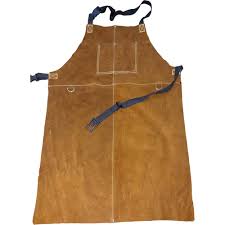
Introduction to Blacksmith Aprons
Blacksmith aprons are a vital component of a blacksmith’s protective gear, designed to provide both safety and functionality in a high-risk environment. Blacksmithing involves working with intense heat, molten metal, and sharp tools, making a robust apron essential for protection and comfort. This guide explores the key features of blacksmith aprons, their benefits, types, and how to properly care for them.
Benefits of a Blacksmith Apron
Superior Heat Resistance
A primary function of a blacksmith apron is to offer protection against extreme heat. Blacksmith aprons are made from durable materials that withstand high temperatures, preventing burns and injuries from molten metal and hot sparks. The apron’s heat-resistant properties ensure that blacksmiths can work safely and efficiently.
Durability and Strength
Blacksmith aprons are built to endure the tough conditions of a forge. Made from high-quality materials like leather or heavy-duty fabrics, these aprons resist abrasion, tearing, and wear. Their durability ensures that they provide long-term protection and reliability in a demanding environment.
Enhanced Safety
Safety is paramount in blacksmithing, and a well-designed apron provides essential coverage. Blacksmith aprons shield against flying sparks, sharp edges, and accidental splashes of hot metal. By offering comprehensive protection, they reduce the risk of injuries and accidents in the workshop.
Comfort and Mobility
Despite their rugged construction, blacksmith aprons are designed for comfort and mobility. Adjustable straps and ergonomic designs ensure that the apron fits well and allows for free movement. This comfort is crucial for blacksmiths who spend long hours at the forge.
Types of Blacksmith Aprons
Leather Blacksmith Aprons
Leather aprons are the gold standard in blacksmithing due to their exceptional heat resistance and durability. Full-grain or top-grain leather aprons are commonly used, offering superior protection against intense heat and sparks. They also develop a distinctive patina over time, adding to their aesthetic appeal.
Canvas Blacksmith Aprons
Canvas aprons are another popular choice, especially when reinforced with additional protective coatings. While not as heat-resistant as leather, high-quality canvas aprons provide adequate protection and are often lighter and more breathable. They are suitable for blacksmiths who prefer a less bulky option.
Synthetic Blacksmith Aprons
Synthetic aprons made from materials like Kevlar or Nomex offer high heat resistance and durability. These aprons are designed to be lightweight and flexible, providing a good balance between protection and comfort. They are often used in combination with other protective gear for enhanced safety.
Key Features to Consider in a Blacksmith Apron
Adjustable Straps
Adjustable straps are crucial for achieving a comfortable and secure fit. Look for aprons with adjustable neck and waist straps that can be customized to fit various body sizes. This feature ensures that the apron stays in place and does not interfere with movement.
Reinforced Seams
Reinforced seams are essential for the apron’s longevity. Double or triple-stitched seams enhance the apron’s durability, preventing it from falling apart under heavy use. Reinforced edges also help prevent fraying and increase the apron’s overall strength.
Pockets and Tool Holders
Pockets and tool holders add functionality to blacksmith aprons. They provide convenient storage for essential tools, gloves, or personal items, keeping them easily accessible. Ensure the pockets are well-placed and secure to avoid interference with your work.
Length and Coverage
The length of the apron should offer adequate coverage to protect the torso and upper legs. A longer apron provides better protection against sparks and molten metal, reducing the risk of burns and injuries. Choose an apron that covers critical areas without restricting movement.
Caring for Your Blacksmith Apron
Cleaning
Proper cleaning is essential to maintain the apron’s condition. For leather aprons, use a damp cloth to wipe away dirt and debris. For canvas or synthetic aprons, follow the manufacturer’s instructions for washing. Avoid using harsh chemicals or soaking the apron, as this can damage the material.
Conditioning
Conditioning leather aprons helps maintain their suppleness and prevent drying out. Apply a leather conditioner or oil regularly to nourish the leather and keep it flexible. Follow the product’s instructions and buff the leather with a soft cloth for a smooth finish.
Storage
Store your blacksmith apron in a cool, dry place to preserve its quality. Avoid exposing it to direct sunlight, which can cause fading and damage. Hang the apron or lay it flat to prevent creases and maintain its shape.
Choosing the Right Blacksmith Apron
Assess Your Needs
Consider your specific requirements when selecting a blacksmith apron. Think about the level of heat protection needed, the type of material that best suits your work environment, and any additional features that would enhance your comfort and safety.
Budget Considerations
Blacksmith aprons come in various price ranges, depending on the material and craftsmanship. While leather aprons may be more expensive, they offer superior durability and protection. Evaluate your budget and choose an apron that provides the best value for your investment.
Brand Reputation and Reviews
Researching brands and reading customer reviews can help you make an informed decision. Look for reputable manufacturers known for their high-quality blacksmith gear and positive feedback from other blacksmiths. This ensures you invest in an apron that meets your standards for safety and performance.
Conclusion
A blacksmith apron is an essential piece of protective gear that combines durability, protection, and comfort. Whether you choose leather, canvas, or synthetic materials, a well-designed apron ensures safety and efficiency in the forge. By selecting an apron with the right features and caring for it properly, you can enhance your blacksmithing experience and safeguard your well-being.